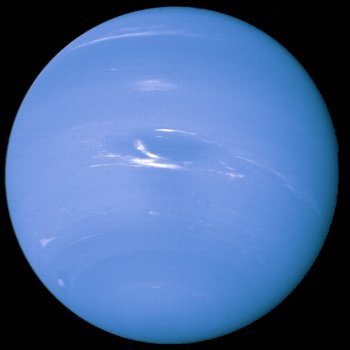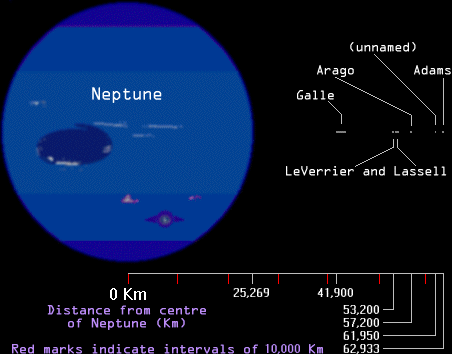Neptune
![]()
Neptune is the outermost of the four gas giants, and is only very slightly smaller than Uranus. When Voyager 2 conducted its flyby in 1989, Neptune had a prominent Great Dark Spot (GDS) - a huge cyclonic storm in its atmosphere similar to the Great Red Spot on Jupiter, but only around half the size. (See image, below.) The wind speeds exceeded 700 mph around it - 700 mph is comparable to the speed of sound. In more recent years, the Hubble Space Telescope (HST) imaged Neptune and found no trace of the GDS, but did see a host of smaller dark storms.

[ NASA / JPL / Caltech ]
| Siderial Period |
Perihelion (AU) |
Aphelion (AU) |
Inclination (degrees) |
Axial Tilt (deg) |
Axial Period (d, h, m) |
|---|---|---|---|---|---|
| 164.79 y | 29.76 | 30.36 | 1.8 | 29.56 | 0, 18, 25.9 |
| Equatorial Diameter (km) |
Oblateness | Mass (Earth = 1) |
Density (water = 1) |
Albedo (geom.) |
No. of Satellites |
| 50, 538 | 0.026 | 17.20 | 1.8 | 0.41 | 8 + R |
Ring system
Voyager 2's first images of Neptune's rings seemed to indicate that it actually had fragments of rings (or ring 'arcs'). When the images were later enhanced and analysed in more detail, Neptune turned out to be orbited by complete rings, but with regions where the material was bunched up in a higher density than other parts of the same ring. The explantion that the scientists came to was that small orbiting satellites had been destroyed by impacts or tidal forces from Neptune in the last decade before the encounter. Otherwise, the debris would have spread itself out along the orbital path of the ring - the bodies did not possess enough mass to pull themselves back together. Voyager's time-lapse images - necessary because of the low light levels at this huge distance from the Sun - recorded particle movement within the ring, causing the arcs to appear denser than they actually are.
Neptune has six rings in total. The cross-section below illustrates the ring system to scale (in terms of radial distance from the centre of Neptune). (Diagram based on data from the NSSDC.)

The Adam's ring contains 5 ring arcs, each around 15 Km across. They are listed below.
![]() Courage
Courage
![]() Liberté
Liberté
![]() Egalité 1
Egalité 1
![]() Egalité 2
Egalité 2
![]() Fraternité
Fraternité
The four innermost of Neptune's eight satellites orbit between the rings. These are Naiad, Thalassa, Despina and Galatea. They are all relatively small objects, less than 165 Km in size.
Missions to Neptune
For a list of missions to Neptune see the links page.